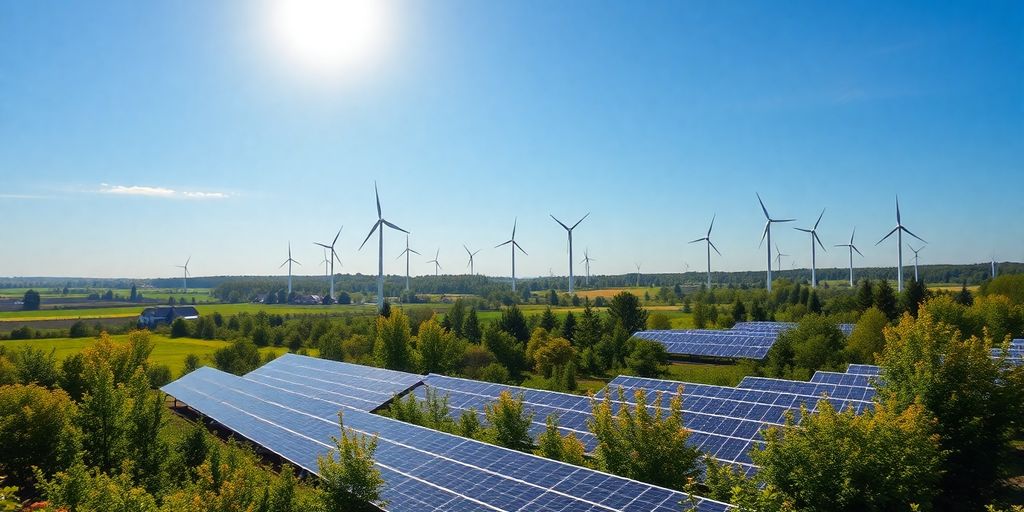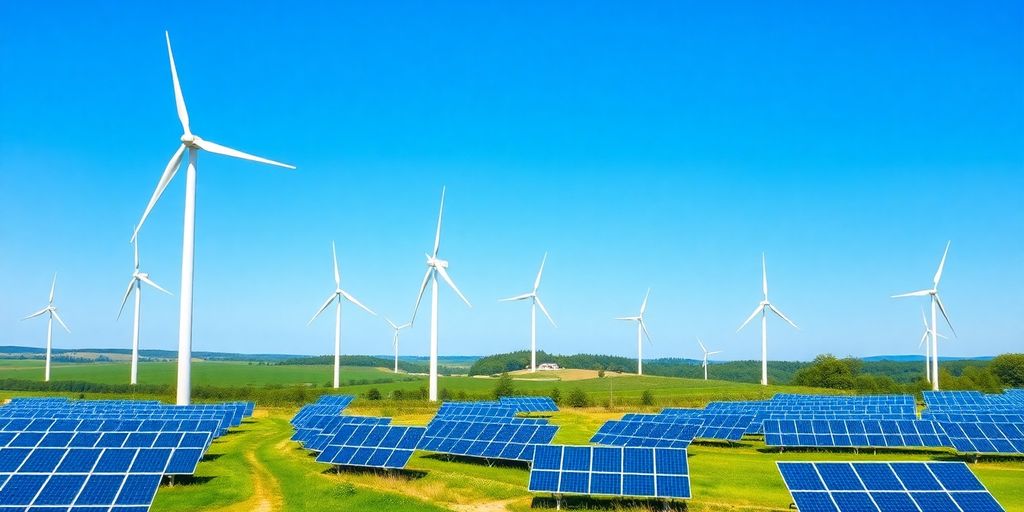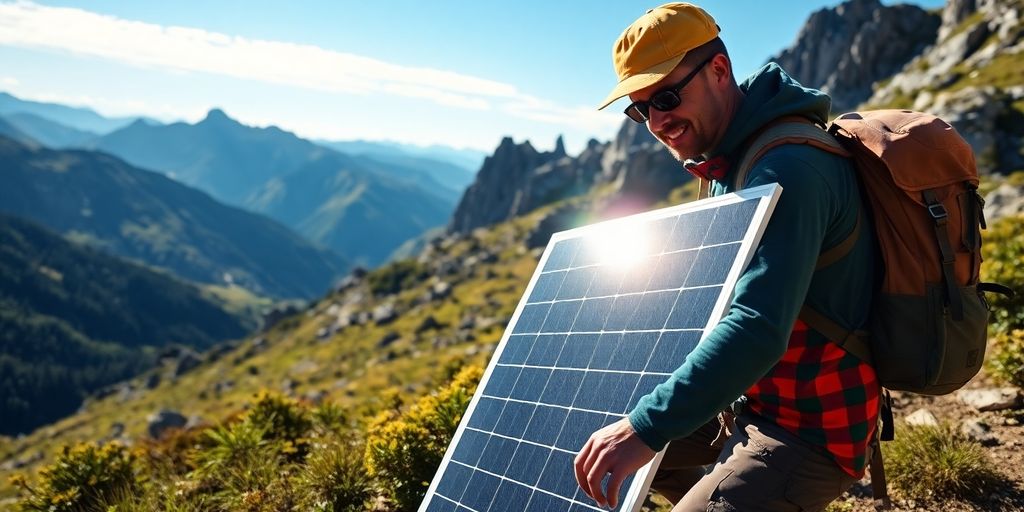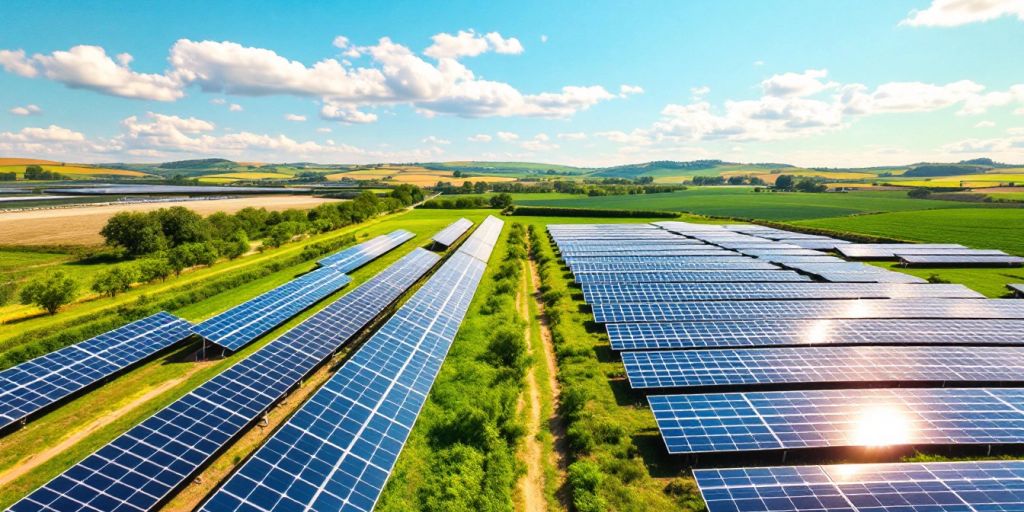Innovative Solutions in the Energy System of Estonia: A Path to Sustainability

Estonia is making waves in the energy world. This small Baltic country is not just talking about sustainability; it’s doing it. With a strong push towards renewable energy and innovative tech, Estonia is setting itself up as a leader in clean energy. From wind power to solar panels, and even biomass, they’re exploring all options to cut down on fossil fuels. It’s not just about the environment, though. Estonia is also looking at the social side of things, making sure everyone benefits from these changes. This article dives into how Estonia is paving the way for a sustainable future, with a focus on the energy system of Estonia.
Key Takeaways
- Estonia is rapidly expanding its use of renewable energy sources like wind, solar, and biomass.
- Technology plays a crucial role in Estonia’s energy transformation, with digital solutions and smart grids leading the charge.
- Community involvement and social equity are central to Estonia’s approach to sustainable energy.
- Government policies and regulations are driving the shift towards a more sustainable energy system.
- Estonia is positioning itself as a global leader in sustainable energy practices.
Harnessing Renewable Energy: Estonia’s Path to a Sustainable Future
Wind Power Expansion and Its Impact
Estonia is making bold moves in wind energy, with plans to double its wind power production by 2025 and triple it by 2027. This expansion isn’t just about numbers; it’s about reducing reliance on fossil fuels and cutting down greenhouse gas emissions. The country’s ambitious offshore wind farm projects, expected to roll out by 2030-2033, are set to be game-changers. These initiatives are not only about energy production but also about fostering local economies through job creation and technological advancements.
Solar Energy Innovations in Estonia
Solar power in Estonia has seen a meteoric rise, shooting from almost zero to 800 MW in just a few years. The goal is to double this capacity by 2030, making solar energy a cornerstone of Estonia’s renewable strategy. This growth is partly due to the dramatic drop in solar technology costs, making it more accessible and appealing. Interestingly, next-generation solar cells from Tallinn University of Technology could offer solutions for environmental monitoring, like forest fire threats, showcasing Estonia’s commitment to innovation.
Biomass Utilization for Energy Independence
Biomass is another key player in Estonia’s renewable energy landscape. By utilizing local resources, Estonia is not only cutting down on fossil fuel imports but also promoting energy independence. The use of biomass, particularly in heating, is set to meet a significant portion of the country’s energy needs by 2030. This shift not only supports sustainability goals but also strengthens the local economy by creating demand for agricultural and forestry by-products.
Estonia’s renewable energy journey is not just about meeting targets; it’s about transforming the energy landscape to ensure a sustainable and independent future. Embracing wind, solar, and biomass, the nation is setting a powerful example for others to follow.
The Role of Technology in Estonia’s Energy Transformation
Digital Solutions for Energy Efficiency
Estonia is at the forefront of using digital technology to improve energy efficiency. The country has embraced smart meters and energy management systems, allowing consumers to monitor and reduce their energy usage. This digital shift not only cuts down on waste but also helps households save money. Digital tools have transformed how energy is consumed and managed in Estonia, making it a leader in smart energy solutions.
Smart Grids and Energy Storage Innovations
The development of smart grids in Estonia is another key factor in its energy transformation. These grids use cutting-edge technology to distribute electricity more efficiently, reducing losses and integrating renewable energy sources seamlessly. With the Riyadh conference emphasizing the importance of technology in environmental solutions, Estonia’s smart grid advancements align perfectly with global efforts. Energy storage solutions are also evolving, with new systems being tested to ensure reliable and efficient energy supply even when the sun isn’t shining or the wind isn’t blowing.
The Rise of Cleantech Startups
Estonia’s vibrant startup ecosystem is a hotbed for cleantech innovation. Companies are developing new technologies to tackle environmental challenges, from renewable energy solutions to waste management. This entrepreneurial spirit is driving the country’s energy transformation, with startups playing a crucial role in creating a sustainable future. The growth of cleantech startups in Estonia is a testament to the country’s commitment to innovation and sustainability.
Community Engagement and Social Equity in Estonia’s Energy System

Grassroots Initiatives for Environmental Conservation
Estonia’s journey towards a sustainable energy future is deeply rooted in community involvement. Across the country, grassroots initiatives are springing up, fostering a collective sense of responsibility for the environment. These initiatives include community gardens, local clean-up events, and educational programs that encourage citizens to engage actively in environmental conservation. Such efforts not only enhance local ecosystems but also build a strong community spirit. By participating in these activities, citizens feel a direct connection to their environment and a shared duty to protect it.
Inclusive Decision-Making Processes
In Estonia, decision-making in the energy sector is not confined to policymakers alone. There’s a strong emphasis on inclusivity, ensuring that diverse voices are heard and considered. Community consultations are held regularly, allowing residents to voice their opinions and concerns about new energy projects. This approach ensures that the development of renewable energy solutions is both democratic and reflective of the community’s needs. Inclusivity in decision-making helps in building trust and transparency, leading to more sustainable and accepted outcomes.
Social Welfare and Sustainability
Estonia places a high priority on social welfare, ensuring that its citizens benefit from the country’s shift towards renewable energy. Universal healthcare, affordable education, and comprehensive social support systems are integral to this approach. These systems ensure that as the country transitions to a greener economy, no one is left behind. By aligning social equity with environmental goals, Estonia demonstrates that sustainability is not just about green energy but also about enhancing the quality of life for all its citizens.
By prioritizing social equity alongside environmental sustainability, Estonia sets a precedent for holistic and inclusive development. The nation’s commitment to these values ensures that its energy transition is not only green but also fair and equitable for all.
Policy and Legislation Driving Estonia’s Energy Transition
Renewable Energy Targets and Milestones
Estonia’s energy landscape is undergoing a major shift, with ambitious targets set to redefine its future. By 2030, the country aims for 100% of its electricity to come from renewable sources. This bold goal is supported by laws that also target 69% renewable energy for heating. These milestones are part of a broader strategy to phase out oil shale and embrace cleaner energy options. The government has also set its sights on boosting wind capacity, with expectations to reach a total renewable capacity of 4525 MW by 2030.
Incentives for Green Investments
To attract investments in green energy, Estonia is rolling out incentives that make it appealing for both local and international investors. A significant policy shift is the exemption of electric storage systems from double taxation. This means storage owners won’t pay renewable energy fees, excise taxes, or grid transmission fees for electricity stored and returned within the same month. Such financial incentives are designed to make green investments more profitable. The government is also preparing policies to support generation volumes that exceed current consumption by 130%, leveraging the allure of affordable green energy.
Regulatory Reforms for Energy Storage
As Estonia pushes forward with its renewable energy agenda, regulatory reforms are paving the way for advanced energy storage solutions. The government is encouraging innovation by supporting pilot schemes and removing financial barriers to storage system implementation. By 2025, Estonia plans to have a regulatory environment that fosters diverse storage solutions, exempting them from burdensome taxes. This not only makes storage systems more economically viable but also allows businesses and individuals to sell unused electricity back to the grid. Such reforms are crucial for balancing supply and demand in a renewable-heavy energy system.
Estonia’s legislative framework is a testament to its commitment to a sustainable energy future, setting an example for others to follow.
Challenges and Opportunities in Estonia’s Energy Landscape
Overcoming Reliance on Fossil Fuels
Estonia’s energy journey has been deeply rooted in fossil fuels, especially oil shale. Transitioning away from this reliance is no small feat. The move towards renewable energy is a bold step, but it demands careful planning and execution. The government has made strides by setting ambitious targets, yet the dependency on traditional energy sources still poses significant hurdles.
Economic Benefits of Renewable Energy
Switching to renewables isn’t just about the environment; it’s also about economic gain. By investing in green energy, Estonia aims to create jobs, stimulate economic growth, and reduce energy costs.
- Job creation in the renewable sector
- Lower energy costs for consumers
- Increased foreign investments
Future Prospects for Offshore Wind Farms
Estonia is looking at offshore wind farms as a promising avenue for energy expansion. These projects, expected to roll out by 2030, could significantly boost the nation’s energy capacity. The potential for offshore wind is vast, but it requires overcoming technical and environmental challenges.
Embracing renewable energy isn’t just about replacing old systems; it’s about envisioning a sustainable future where energy is clean, affordable, and accessible to all. Estonia’s path is paved with both challenges and opportunities, and the balance between the two will shape the country’s energy landscape for years to come.
In the broader context, Estonia’s efforts are a part of a larger regional push for energy security and integration, as seen in the Baltic states’ energy initiatives. This regional collaboration highlights the interconnected nature of modern energy challenges and solutions.
Education and Innovation: Building a Sustainable Energy Future

Estonia’s focus on STEM education is like the backbone of its energy revolution. From a young age, students dive into science, technology, engineering, and math, setting the stage for a skilled workforce ready to tackle the energy challenges of tomorrow. This emphasis on education is crucial for driving technological advancements across various sectors. Estonia’s educational system is designed to encourage curiosity and problem-solving, equipping students with the tools needed to innovate and lead in the energy sector.
Entrepreneurship in the Energy Sector
Entrepreneurship is thriving in Estonia, especially in the energy sector. With a supportive environment for startups, many entrepreneurs are venturing into renewable energy, creating solutions that are not only innovative but also sustainable. The country’s commitment to fostering a business-friendly climate has led to a surge in cleantech startups, which are playing a pivotal role in Estonia’s energy transformation. These startups are not just contributing to the economy but are also vital players in the global push for sustainable energy solutions.
Research and Development in Clean Technologies
Research and development (R&D) is at the heart of Estonia’s push towards a sustainable energy future. Universities and research institutions are collaborating with industry leaders to explore new technologies and improve existing ones. Innovation in areas like energy storage, smart grids, and renewable energy sources is being prioritized, ensuring Estonia remains at the forefront of the clean energy movement. This collaborative approach not only accelerates technological advancements but also ensures that Estonia can meet its ambitious energy goals.
Estonia’s Global Leadership in Sustainable Energy Practices
International Collaborations and Partnerships
Estonia’s commitment to sustainability is not just a local affair; it’s a global mission. The country actively engages in international collaborations to exchange knowledge and drive innovation in renewable energy. By partnering with other nations, Estonia has accelerated its transition to a sustainable energy system. These partnerships often focus on technology exchange, joint research projects, and shared investments in clean energy initiatives. This global approach ensures that Estonia remains at the forefront of sustainable energy practices.
Showcasing Estonia’s Success Stories
Estonia’s journey towards a sustainable future is filled with impressive milestones. From achieving significant reductions in carbon emissions to pioneering digital solutions for energy efficiency, Estonia has set a benchmark for others to follow. The country’s focus on renewable energy has led to a remarkable increase in wind and solar power usage, positioning it as a leader in the European Union. These success stories are not just about numbers; they reflect the determination and innovation that drive Estonia’s energy policies.
Lessons for Other Nations
As Estonia continues to lead in sustainable energy, it offers valuable lessons for countries worldwide. The emphasis on community involvement, technological innovation, and international cooperation provides a blueprint for others looking to transition to renewable energy. By learning from Estonia’s experiences, other nations can adopt similar strategies to enhance their own sustainability efforts. Estonia’s success demonstrates that with the right mix of policy, technology, and community engagement, a sustainable energy future is within reach for all.
Conclusion
Estonia’s journey towards a sustainable energy system is nothing short of inspiring. This small nation has shown that with determination and innovation, significant strides can be made in renewable energy and environmental conservation. By embracing wind and solar power, Estonia is not just reducing its carbon footprint but also setting a benchmark for others to follow. The country’s commitment to social equity and community involvement further strengthens its sustainability efforts, ensuring that the benefits of a green economy are shared by all. As Estonia continues to push the boundaries of what’s possible in clean energy, it stands as a beacon of hope and a model for sustainable development worldwide. The path may be challenging, but Estonia’s progress proves that a sustainable future is within reach.
Frequently Asked Questions
What is Estonia’s plan for renewable energy by 2030?
Estonia aims to power its future entirely with renewable energy sources by 2030. This includes increasing wind and solar power and developing offshore wind farms.
How much of Estonia’s energy currently comes from renewable sources?
As of now, about 31% of Estonia’s electricity consumption comes from renewable sources, and this number is steadily increasing.
What role does technology play in Estonia’s energy transformation?
Technology is crucial in Estonia’s energy transformation, with innovations in smart grids, energy storage, and cleantech startups leading the way.
How does Estonia involve its communities in sustainable energy efforts?
Estonia encourages community engagement through grassroots initiatives and inclusive decision-making processes, ensuring everyone has a voice in sustainability efforts.
What educational focus supports Estonia’s energy goals?
Estonia places a strong emphasis on STEM education, fostering a skilled workforce that can drive technological advancements in the energy sector.
What are the economic benefits of Estonia’s shift to renewable energy?
The shift to renewable energy is expected to bring economic benefits by reducing reliance on fossil fuels, attracting green investments, and creating jobs in new energy sectors.







Responses